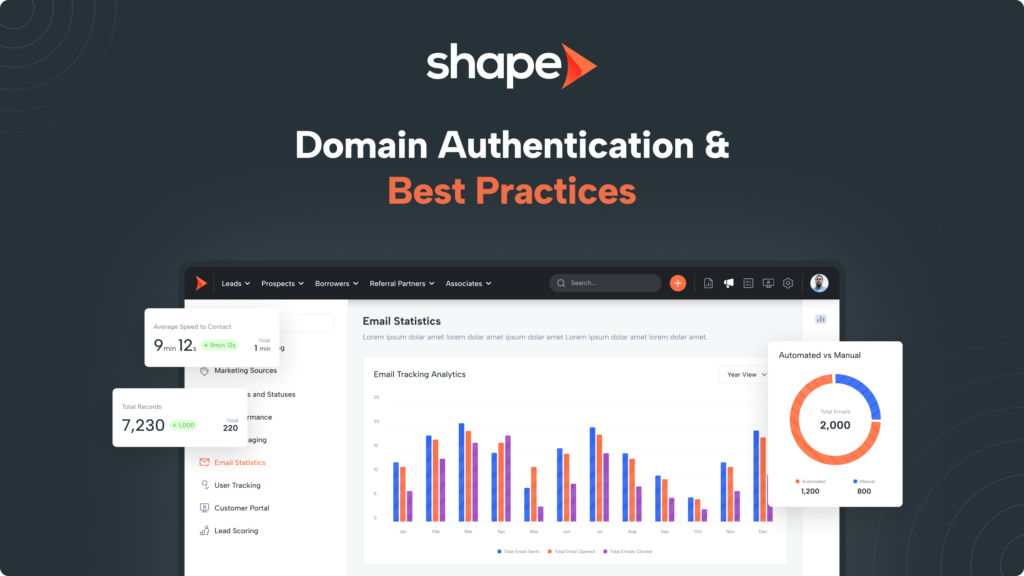
This guide covers best practices for list management, authentication, and content optimization.
By following these best practices, you can improve your email deliverability, engagement, and overall effectiveness of your email marketing efforts. Regularly reviewing and updating your email strategies ensures that you stay compliant with regulations and continue to provide value to your subscribers.
Firstly, choose your preferred subdomain for authentication. This is usually your company name, such as “mail.[yourdomain].com”.
Once you have chosen your subdomain, send an email to help@setshape.com with the details including your chosen subdomain. This will allow our support team to continue with the following steps.
Once we have received your chosen subdomain, our team will begin the authentication process.
This will including providing you with the recommended DNS settings that will need to be entered into your DNS.
Copy and paste the DNS settings provided by our team into your host service. The location of these settings vary from host to host so you will find guides from common hosts (GoDaddy, HostGator, Bluehost, DreamHost, etc) at the bottom of this guide!
If you do not see the host listed here, please reach out to your host service for instruction on how to complete this step.
Once you have inserted the recommended DNS settings, notify our Support team by emailing help@setshape.com as soon as possible.
Once we have been notified, our team of experts will verify the DNS settings have been entered correctly and match.
The last step of authenticating your email domain is for our internal team to QA the adjustments and ensure everything is operating as expected!
Email marketing is a powerful tool for businesses to connect with their audience, but it requires careful management to ensure high deliverability, engagement, and compliance with regulations.
Below are best practices for staying on top of your email marketing habits:
Effective list management is crucial for maintaining a healthy email list and ensuring your emails reach the intended recipients.
Email authentication is essential for verifying your identity as a sender, protecting your domain from being spoofed, and improving email deliverability. More and more email providers are requiring received emails to be sent through an authenticated subdomain. Traffic not sent through an authenticated subdomain usually ends up in the dreaded spam box!
To mitigate this, Shape offers domain authentication to our customers to ensure their email marketing efforts have the best chance to land in the recipients inbox. To learn more about the authentication process, do not hesitate to reach out to our support team by emailing support@setshape.com.
Below are some key terms to know when making adjustments to your domain's DNS settings:
Optimizing your email content is key to engaging your audience and achieving your marketing goals. Shape makes content creation easy with Shape A.I that can be accessed directly from your Dashboard.
Simply type in the tone and content you want included in the email and let Shape A.I do the work drafting the content for you.
Below are some additional tips for crafting engaging email content:
Email authentication is crucial for several reasons, all of which contribute to ensuring the integrity, security, and reliability of email communication.
By implementing these email authentication protocols, organizations can significantly reduce the risks associated with email-based threats, enhance their email deliverability, and protect your brand reputation.
Below we are including helpful links to support articles from common domains that our customer's utilize. These guides will help to locate the DNS settings that will need to be adjusted to authenticate your subdomain:
Shape, like other CRM platforms and reputable communication tools, requires users to maintain a low bounce rate to ensure the quality and reliability of its email delivery services. Here are the reasons why Shape enforces this requirement.
By requiring users to maintain low bounce rates, Shape ensures the effectiveness, reliability, and quality of its email delivery service, benefiting both the platform and its users.
Keywords: domain, authenticate, subdomain, DNS, DKIM, SPF, spam, provider, email, TXT, best practices, bounce, email bounce

Changing templates will take time and may require a template change fee.
Not sure what to choose? Contact us.